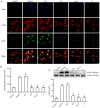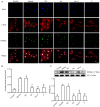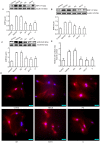Interactions between the ERK1/2 signaling pathway and PCAF play a key role in PE‑induced cardiomyocyte hypertrophy
- PMID: 34278478
- PMCID: PMC8281443
- DOI: 10.3892/mmr.2021.12275
Interactions between the ERK1/2 signaling pathway and PCAF play a key role in PE‑induced cardiomyocyte hypertrophy
Abstract
Cardiomyocyte hypertrophy is a compensatory phase of chronic heart failure that is induced by the activation of multiple signaling pathways. The extracellular signal‑regulated protein kinase (ERK) signaling pathway is an important regulator of cardiomyocyte hypertrophy. In our previous study, it was demonstrated that phenylephrine (PE)‑induced cardiomyocyte hypertrophy involves the hyperacetylation of histone H3K9ac by P300/CBP‑associated factor (PCAF). However, the upstream signaling pathway has yet to be fully identified. In the present study, the role of the extracellular signal‑regulated protein kinase (ERK)1/2 signaling pathway in PE‑induced cardiomyocyte hypertrophy was investigated. The mice cardiomyocyte hypertrophy model was successfully established by treating cells with PE in vitro. The results showed that phospho‑(p‑)ERK1/2 interacted with PCAF and modified the pattern of histone H3K9ac acetylation. An ERK inhibitor (U0126) and/or a histone acetylase inhibitor (anacardic acid; AA) attenuated the overexpression of phospho‑ERK1/2 and H3K9ac hyperacetylation by inhibiting the expression of PCAF in PE‑induced cardiomyocyte hypertrophy. Moreover, U0126 and/or AA could attenuate the overexpression of several biomarker genes related to cardiac hypertrophy (myocyte enhancer factor 2C, atrial natriuretic peptide, brain natriuretic peptide and β‑myosin heavy chain) and prevented cardiomyocyte hypertrophy. These results revealed a novel mechanism in that AA protects against PE‑induced cardiomyocyte hypertrophy in mice via the ERK1/2 signaling pathway, and by modifying the acetylation of H3K9ac. These findings may assist in the development of novel methods for preventing and treating hypertrophic cardiomyopathy.
Keywords: ERK‑signaling pathway; anacardic acid; cardiomyocyte hypertrophy; histone acetylation.
Conflict of interest statement
The authors declare that they have no competing interests.
Figures







Similar articles
-
JNK signaling-dependent regulation of histone acetylation are involved in anacardic acid alleviates cardiomyocyte hypertrophy induced by phenylephrine.PLoS One. 2021 Dec 16;16(12):e0261388. doi: 10.1371/journal.pone.0261388. eCollection 2021. PLoS One. 2021. PMID: 34914791 Free PMC article.
-
Anacardic acid attenuates pressure-overload cardiac hypertrophy through inhibiting histone acetylases.J Cell Mol Med. 2019 Apr;23(4):2744-2752. doi: 10.1111/jcmm.14181. Epub 2019 Feb 3. J Cell Mol Med. 2019. PMID: 30712293 Free PMC article.
-
Phenylephrine-induced cardiac hypertrophy is attenuated by a histone acetylase inhibitor anacardic acid in mice.Mol Biosyst. 2017 Mar 28;13(4):714-724. doi: 10.1039/c6mb00692b. Mol Biosyst. 2017. PMID: 28194469
-
Function of histone methylation and acetylation modifiers in cardiac hypertrophy.J Mol Cell Cardiol. 2021 Oct;159:120-129. doi: 10.1016/j.yjmcc.2021.06.011. Epub 2021 Jun 24. J Mol Cell Cardiol. 2021. PMID: 34175302 Review.
-
MEF2 in cardiac hypertrophy in response to hypertension.Trends Cardiovasc Med. 2023 May;33(4):204-212. doi: 10.1016/j.tcm.2022.01.002. Epub 2022 Jan 11. Trends Cardiovasc Med. 2023. PMID: 35026393 Review.
Cited by
-
Lithium Treatment Induces Cardiac Dysfunction in Mice.Int J Mol Sci. 2023 Nov 1;24(21):15872. doi: 10.3390/ijms242115872. Int J Mol Sci. 2023. PMID: 37958854 Free PMC article.
-
miR-1 as a Key Epigenetic Regulator in Early Differentiation of Cardiac Sinoatrial Region.Int J Mol Sci. 2024 Jun 15;25(12):6608. doi: 10.3390/ijms25126608. Int J Mol Sci. 2024. PMID: 38928314 Free PMC article.
-
Roles of histone acetylation sites in cardiac hypertrophy and heart failure.Front Cardiovasc Med. 2023 Mar 15;10:1133611. doi: 10.3389/fcvm.2023.1133611. eCollection 2023. Front Cardiovasc Med. 2023. PMID: 37008337 Free PMC article. Review.
-
Cardiac Acetylation in Metabolic Diseases.Biomedicines. 2022 Jul 29;10(8):1834. doi: 10.3390/biomedicines10081834. Biomedicines. 2022. PMID: 36009379 Free PMC article. Review.
-
Pharmacological inhibition of the acetyltransferase Tip60 mitigates myocardial infarction injury.Dis Model Mech. 2023 May 1;16(5):dmm049786. doi: 10.1242/dmm.049786. Epub 2022 Nov 7. Dis Model Mech. 2023. PMID: 36341679 Free PMC article.
References
-
- Degoricija V, Trbušić M, Potočnjak I, Radulović B, Terešak SD, Pregartner G, Berghold A, Tiran B, Frank S. Acute heart failure developed as worsening of chronic heart failure is associated with increased mortality compared to de novo cases. Sci Rep. 2018;8:9587. doi: 10.1038/s41598-018-28027-3. - DOI - PMC - PubMed
MeSH terms
Substances
LinkOut - more resources
Full Text Sources
Miscellaneous

